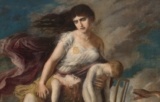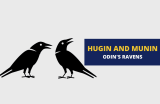Medea was a powerful enchantress in Greek mythology, famous for the role she played in many adventures faced by Jason and the Argonauts on the quest for the ...
In Greek mythology, Euterpe was one of the Nine Muses, the minor goddesses who inspired and guided mortals to excel in the arts and sciences. Euterpe ...
Erato is regarded as one of the nine Greek Muses, the minor goddesses responsible for inspiring the Ancient Greeks to excel in the arts and sciences. Erato ...
Enyo was a goddess of war in Greek mythology. She was often portrayed as the companion of Ares, the god of war, and took pleasure in seeing bloodshed and ...
In Greek mythology, Hecuba (or Hekabe), was the wife of Priam, the king of Troy. Her story has been chronicled in Homer’s Iliad, where she appears as a ...
Deucalion was the son of the Titan Prometheus in Greek mythology and the Greek equivalent of the Biblical Noah. Deucalion is closely connected with the ...
In Greek mythology, Boreas was the personification of the north wind. He was also the god of winter and the bringer of cold air with his ice-cold breath. ...
Mortuary rituals were a fundamental part of ancient Egyptian culture and consisted of several steps in a long process. Within the mummification process, the ...
Egyptian mythology teems with remarkable artifacts and objects that represented important concepts. The Was Scepter, among the most important of Egyptian ...
The Allfather god Odin is typically depicted with a pair of ravens on his shoulders. Odin’s ravens, known as Huginn and Muninn (pronounced HOO-gin and ...
Pelias was the king of the city of Iolcus in ancient Greece. He’s famous for his appearance in the tale of Jason and the Argonauts, one of the most well ...
In Greek mythology, Eos was the Titan goddess of the dawn who lived at the border of the Oceanus. She was said to have rosy forearms, or rosy fingers, and ...
- « Previous Page
- 1
- …
- 29
- 30
- 31
- 32
- 33
- …
- 38
- Next Page »













